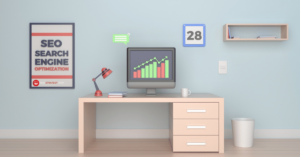Search engines reward well-structured websites. A clean design makes your site easier to crawl, faster to load, and more engaging for visitors. SEO-focused site design tips help your business grow without relying on ads when done right.
Every detail matters—your site’s structure, speed, and content all influence rankings. This guide breaks down the essential site design tips for SEO. By following these strategies, you’ll build a website that attracts visitors and converts them into loyal customers and 10X your results with your digital marketing plan.
The Role of SEO in Site Design
Search Engine Optimization (SEO) isn’t just about keywords. It’s about designing a site that search engines and users love.
A well-optimized website ranks higher, gets more traffic, and improves user experience. In the early days, SEO relied on keyword stuffing and spammy links. Today, Google rewards sites with fast loading speeds, clear navigation, and mobile-friendly layouts.
Good site design leads to better crawlability, faster indexing, and higher engagement, so SEO and web design must work together.

3 Key Site Design Tips for SEO
- Use a logical site structure. Organize pages in a way that makes sense. A well-structured site helps search engines find and index content faster.
- Make pages load in under three seconds. Compress images, enable caching, and remove unnecessary code. A faster site improves rankings and reduces bounce rates.
- Optimize for mobile-first indexing. Google prioritizes mobile-friendly sites. Ensure your site adapts to all screen sizes.
Technical SEO: Building a Search-Friendly Foundation
Technical SEO ensures search engines can crawl, index, and rank your website. A well-structured site provides a solid foundation for long-term SEO success.
3 Essential Site Design Tips for Technical SEO
- Simplify URL structures.
- What to do: Use short, keyword-rich URLs without extra characters or numbers.
- Why it works: Clean URLs improve readability and help search engines categorize content.
- Improve site speed with better hosting.
- What to do: Choose a fast, reliable hosting provider and enable browser caching.
- Why it works: Faster loading times reduce bounce rates and improve rankings.
- Secure your site with HTTPS.
- What to do: Install an SSL certificate and update all site links to HTTPS.
- Why it works: Google prioritizes secure sites, and users trust them more.
3 Simple Steps for Better Technical SEO
- Run a site speed test using Google PageSpeed Insights. Fix issues slowing down your site.
- Set up Google Search Console to track indexing issues and optimize performance.
- Use structured data (schema markup) to help search engines understand your content better.
To read more about Technical SEO, read our article Technical SEO Guide: 7 Simple Fixes to Improve Your Website’s Rankings Today.
On-Page SEO: Optimizing Individual Pages for Search
On-page SEO involves optimizing content, images, and HTML elements. Well-structured pages help search engines rank your content higher.
3 Effective Site Design Tips for On-Page SEO
- Use header tags (H1, H2, H3) to structure content.
- What to do: Break up text into sections with clear headings.
- Why it works: It improves readability and helps search engines understand your content.
- Write compelling title tags and meta descriptions.
- What to do: Keep title tags under 60 characters and meta descriptions under 160.
- Why it works: Increases click-through rates (CTR) from search results.
- Optimize images with alt text and compression.
- What to do: Use descriptive alt tags and reduce file sizes.
- Why it works: Improves accessibility and page load times.
3 Simple Steps for On-Page Optimization
- Research high-ranking keywords and use them naturally in your content.
- Write engaging, easy-to-read blog posts that keep visitors on your site longer.
- Use internal links to guide users to relevant pages and improve site structure.
To learn more about on-page SEO, read our article 6 On-Page SEO Basics That Make Every Blog Post an Awesome Piece of Content.
Off-Page SEO: Building Authority and Credibility
Off-page SEO focuses on improving your site’s authority through backlinks and social engagement. A well-designed site encourages others to link to it.
3 Site Design Tips for Off-Page SEO
- Make your site visually appealing.
- What to do: Use clean layouts, easy-to-read fonts, and professional graphics.
- Why it works: People are likelier to share and link to a well-designed site.
- Encourage social sharing with easy-to-find buttons.
- What to do: Add visible social media share buttons on blog posts.
- Why it works: More shares lead to more visibility and backlinks.
- Get featured on authority websites.
- What to do: Write guest posts or get mentioned on reputable industry sites.
- Why it works: Backlinks from trusted sites boost search rankings.
3 Simple Steps for Stronger Off-Page SEO
- Create high-value content that others want to link to.
- Engage in industry communities by contributing to discussions and forums.
- Track backlinks using SEO tools like Ahrefs or Moz.
To read more about Off-Page SEO, read our article 5 Simple Off-Page SEO Tips That Deliver Massive Results Fast.
Content and Blog SEO: Creating Traffic-Generating Pages
A blog optimized for SEO attracts consistent, organic traffic. Well-structured posts rank higher and keep readers engaged.
3 Site Design Tips for Blog SEO
- Use a scannable format with short paragraphs.
- What to do: Break up content with subheadings, bullet points, and whitespace.
- Why it works: It makes content easier to read and keeps users engaged.
- Target long-tail keywords for blog topics.
- What to do: Research specific search queries using tools like Ubersuggest.
- Why it works: Long-tail keywords have less competition and higher conversion rates.
- Update old blog posts with fresh data.
- What to do: Add new stats, images, and internal links.
- Why it works: Google favors updated content, keeping it ranking longer.
3 Simple Steps for Blog SEO
- Plan keyword-driven blog topics based on what people are searching for.
- Write valuable, in-depth articles that solve user problems.
- Optimize headlines and meta descriptions to improve CTR.
To read more about Content and Blog SEO read this article Content Strategy Role in SEO: How to Create Traffic-Boosting Content.
E-Commerce SEO: Optimizing Online Stores for Search
E-commerce SEO helps online stores rank higher in product searches. Good site design improves both SEO and sales.
3 Site Design Tips for E-Commerce SEO
- Optimize product pages with keyword-rich descriptions.
- Use breadcrumb navigation to improve user experience.
- Implement product schema markup for better visibility.
3 Simple Steps for E-Commerce SEO
- Find high-traffic product keywords using SEO tools.
- Write unique descriptions for every product to avoid duplicate content.
- Improve mobile usability so shoppers can easily browse and buy.
To read more about E-Commerce SEO read this article The #1 Ultimate Guide to E-Commerce SEO: How to Rank, Convert, and Scale.
SEO Analytics: Tracking and Improving Performance
SEO isn’t set-and-forget. Tracking performance helps improve rankings over time.
3 Site Design Tips for SEO Analytics
- Monitor site speed and fix slow-loading pages.
- Track keyword rankings and adjust strategies.
- Analyze user behavior with heatmaps.
3 Simple Steps for SEO Analytics
- Set up Google Analytics to track organic traffic.
- Use Google Search Console to monitor indexing issues.
- Run regular SEO audits to fix errors and optimize performance.
Final Thoughts
SEO-focused site design is the key to long-term success. A well-structured website attracts more traffic, ranks higher, and converts better.
Implementing these site design tips will help you create a site that works for both users and search engines. Start with technical SEO, optimize content, and build authority with off-page strategies. Over time, your rankings and organic traffic will grow without relying on paid ads.
Ready to build a high-ranking website? Apply these strategies today and watch your traffic soar. 🚀
Affiliate Disclaimer: This post contains affiliate links. If you purchase through them, I may earn a commission at no extra cost to you.




